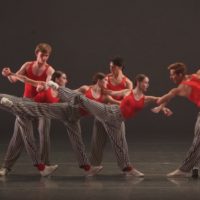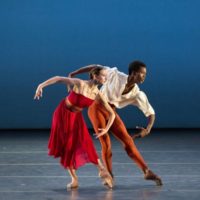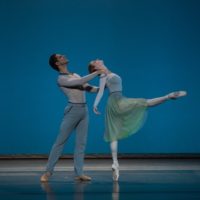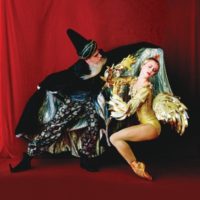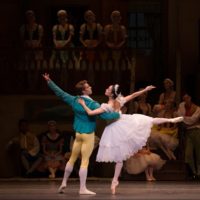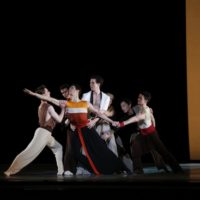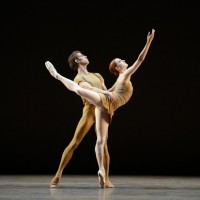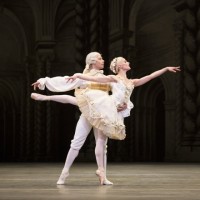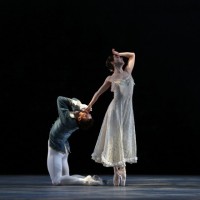Do you ever wonder how choreographers choose their titles? After seeing James Whiteside’s New American Romance on the last day of American Ballet Theatre’s fall season at the former New York State Theater, I spent some time pondering that. The five women in its cast of eight wear dark blue, swirling, ankle-length tutus (provided by Primadonna). The music to which Whiteside set his ballet, … [Read more...]
Tharp Times Three
American Ballet Theatre's Tharp Trio at Lincoln Center, May 30-June 3 Does anyone dare to call Giselle dated? I doubt it. It’s a centuries-old classic that’s had numerous facelifts. I don’t often wish myself back at its premiere in 1832. However, feeling a twinge of nostalgia for something in your own not-so-distant past can be enriching when contemplating it anew. I wrote my review of … [Read more...]
American Ballet Theatre Throws a Party
ABT presents new and recent ballets at Lincoln Center through October 29th. As diverse and original as Alexei Ratmansky’s ballets are, it’s tempting to probe for artistic sources that may have nourished them. His Russian roots include his experiences as a dancer in the Kirov Ballet and as the Bolshoi Ballet’s artistic director. His years as a member of the Royal Danish Ballet count too. Few … [Read more...]
Moving Architecture
American Ballet Theatre presents ballets by Tharp, Lang, and Millepied. Goethe once wrote this: “Music is liquid architecture; architecture is frozen music.” For Havelock Ellis—one of the writers on the arts that Martha Graham and Doris Humphrey found inspiring early in the twentieth century—dance and architecture were the sources on which the visual arts were built. Watching one of … [Read more...]
Once Upon a Time. . .
American Ballet Theater mounts Alexei Ratmansky's The Golden Cockerel. It occasionally happens that a ballet from another era comes to us tangled in its own history, even as it tries to make sense of it. American Ballet Theatre’s production of The Golden Cockerel as re-imagined by Alexei Ratmansky is just such a work—gorgeous to look at, often comical, often perplexing. At the end of the … [Read more...]
Love Finds a Way
American Ballet Theatre revives its production of Frederick Ashton's La Fille mal gardée. If I had been able to write about American Ballet Theatre’s production of Frederick Ashton’s La Fille Mal Gardée before the company’s performances of it ended on May 30, I would have said, “if you’re having a bad day, go see this ballet.” So fragrant, so tender is its depiction of love, innocence, … [Read more...]
Speaking of Love
Alexei Ratmansky introduces Plato to American Ballet Theatre in its Lincoln Center season. Serenade after Plato’s Symposium is the twelfth ballet that Alexei Ratmansky has choreographed for American Ballet Theatre in the past seven years; clearly he takes his position as the company’s artist in residence seriously. This beautiful new chamber ballet is subtly different from anything of his … [Read more...]
Perspectives on Classicism
American Ballet Theatre opens it Lincoln Center season with ballets by Morris, Ashton, and Tharp Ask a choreographer bred in modern dance to create a ballet for an esteemed classical company, and what ensues? If the choreographer in question is Mark Morris or Twyla Tharp, the resultant work often both honors tradition and knocks it around a little. This seemed true at American Ballet … [Read more...]
The Sleeping Beauty Wakes Up
Alexei Ratmansky brings an 1890 ballet to new life for American Ballet theatre. American Ballet Theatre is no stranger to The Sleeping Beauty. As Ballet Theatre, the new company in town in 1941, the dancers performed Princess Aurora, Anton Dolin’s mash-up of elements from the Prologue and Act III of Marius Petipa’s 1890 masterwork. ABT presented its first full-length version in 1976, its … [Read more...]
Keeping a Heritage Alive
American Ballet Theatre opens its Lincoln Center season with one-act masterworks from its repertory. When watching the classics of 19th-century and early 20th-century ballet, it’s wise not to ask too many questions. When enjoying Michel Fokine’s 1909 Les Sylphides, for instance, you’re not supposed to wonder what this lone man is doing amid all these women in long, gauzy, white tutus, two … [Read more...]


